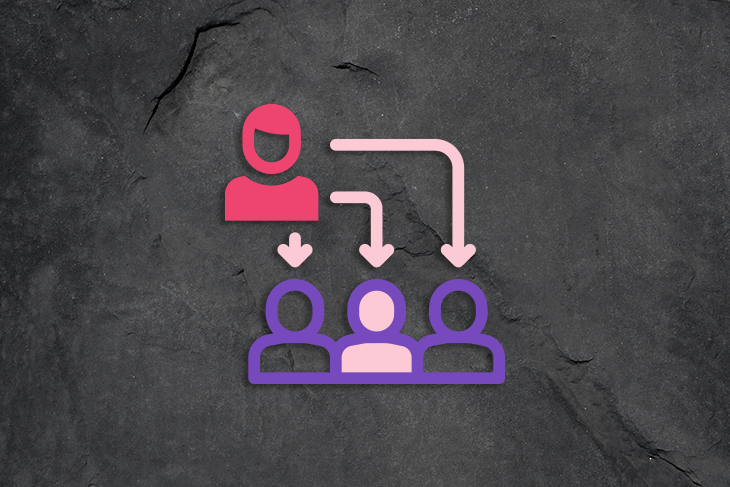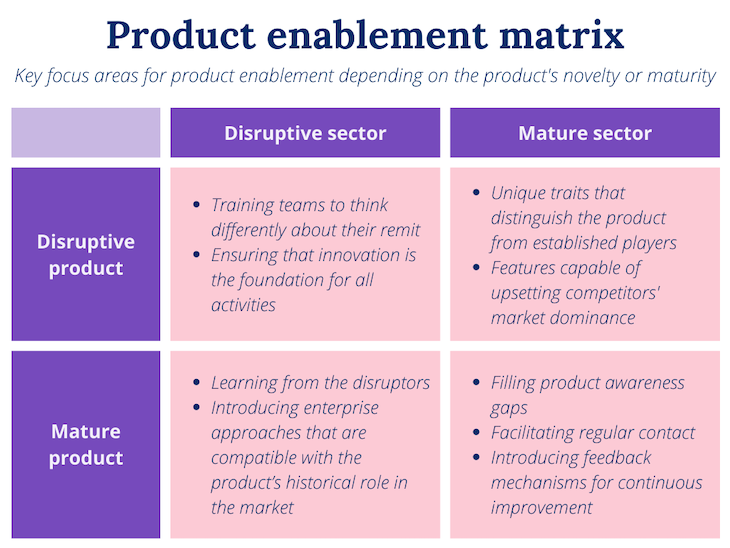If you know a little about product enablement, you might think it’s irrelevant as long as you have a competent product team. If you know nothing about it, you would be forgiven for confusing it with product management or product marketing.

Both perspectives are wrong. The fact is that product enablement is an increasingly essential attribute for cross-company teams.
Let’s start with the basics: how do we define product enablement? Then, we’ll outline key benefits and scenarios where product enablement skills come in handy.
Finally, we‘ll summarize the product enablement manager’s job description and responsibilities and highlight the distinction between this role, product marketing, and product management.
Companies big and small thrive through specialization. This principle also applies to teams, particularly those of a technical nature.
Designers and developers behind our favorite apps spend years refining their talents. However, this expertise also generates a certain distance between company divisions, which does not necessarily align with hierarchy.
Siloing, as this process is commonly called, can even happen between project teams that are meant to be at the same level.
The dangers of siloing are many. Lack of communication, missed deadlines, overlooked flaws, misaligned incentives, just to name a few. It can even create animosity between members of the same project if allowed to fester.
As a solution, more and more business leaders are paying attention to companywide skills that can help counteract these negative tendencies. Product enablement is one of those key vaccines against silos.
In short, product enablement refers to the mechanisms by which members of an organization gain insight into the products the company is producing and selling to the public.
You might assume this comes naturally to any important team or individual, regardless of your position in the production chain. If you’re in research and development, for example, you should be aware of key features and areas for improvement. If you’re in direct-to-consumer sales, you should know what you’re trying to convince the public to buy.
However, as any human resources manager or recruiter will be able to tell you, this knowledge is often surface-level. Team leaders and members simply know enough to carry out their tasks. But the point of product enablement is to go beyond that.
The goal is for your product’s design decisions, functional features, and singular selling points to permeate the enterprise and structure the viewpoints and action points relevant to each division.
In the same way you would want everyone in your organization to understand market conditions and target audiences, it’s generally a good idea to instill some degree of product knowledge into all members of your company.
Let’s dig into some specific benefits of actively promoting product enablement.
Designers can be a bit particular about their choices, but chances are they know what they’re doing. From colors, to notifications, to schedules, the choices designers and their teams make are backed by insights and countless experiments.
Sadly, as their work goes through multiple teams and adaptations, those in the downstream often misunderstand or misconstrue the decisions behind a customer relations tool or a payment solution. Product enablement, operating bidirectionally, will help customer-facing divisions better understand the thought processes and constraints behind design choices.
You might have noticed that awareness, a word usually employed with “brand,” has been replaced here by primacy.
In the case of design, it is enough for colleagues to know why certain decisions were made. Your brand, however, deserves more than that.
Branding goes beyond logos and corporate colors: it is your firm’s soul, your unique way of doing things and solving problems, that makes you stand out in a crowded market. Through product enablement activities (more on that below), you can preach to your teams how your brand should reflect on their current work and future projects.
While your brand is likely to be a stable feature influencing your product delivery, there are many moments in a company’s history where it’s the smaller projects that matter.
Whether you’re launching a new line, sunsetting an old feature or refurbishing your website, strong product enablement channels allow these changing goals to spread across company divisions.
Moments of change can be chaotic, but if shared goals regarding your product’s evolution are communicated quickly and effectively, you will avoid pitfalls and be able to focus on fundamentals.
Rethinking, retooling, and revamping the way your team works is a key principle of agile product development. That said, in today’s busy, shared workspaces, it is often difficult for teams and individuals to look beyond their immediate concerns.
A shared product mentality can foster creative sparks, something product management promotes through extensive testing and iterating. Here, feedback is not a passive process at the end of the line, but an active pathway to creativity.
Some of today’s most successful company offerings came from creative decisions spurred by companywide product enablement. One key example is Amazon Web Services. Initially an internal tool, it was rolled out externally in response to countless insights offered by various Amazon teams.
There is plenty to be gained from pursuing product enablement in any business. Spreading design thinking, upholding your brand’s unique selling proposition (USP), coordinating project targets, and unlocking the power of product feedback can benefit all teams at all times.
At the same time, all companies and products are not created equal. Here is an outline of product enablement priorities according to company and product type.
Believe it or not, managers of companies with well-known brands and products often discover, to their horror, that teams are completely oblivious to basic elements that define their brand’s legacy. If an official or unofficial survey reflects this lack of product awareness, it might be time to articulate product enablement teams.
The hardest work for product enablement teams is dispelling common misconceptions and approaches that might have become fossilized through years and even decades of informal product knowledge. A back-to-basics perspective is often the best starting point.
It is true that many small companies, especially in the earliest stages, lack the funds required to hire dedicated product managers. A product enablement manager might become a secondary goal in situations where resources are scarce. Nonetheless, while PMs are the most typical product enablement leaders, any manager or even the CEO can take on this responsibility in a pinch.
Building a product-centered culture from scratch is one of the best seeds for start-up success. Even if the company misses out on future growth, everyone who has taken part in the project will benefit from expanded product knowledge for their next adventure.
Companies that are expanding rapidly in either scale or scope often overlook the softer skills that play an equally critical role in product success.
Whether you’re concerned with ramping up production at an overseas plant or obtaining regulatory approval to enter a new market, paying attention to design philosophies and customer-centric principles might seem like a waste of time. However, it is precisely at these moments of growth that product enablement can shine.
Think of all the new market intelligence that is ready to be collected by product-enabled customer service teams working in those new markets. If you have these structures in place by the time you start to ascend, you will have solid foundations to consolidate your expansion.
Chances are, if you’ve imbued your value chain with product awareness, you can prevent many catastrophic issues from emerging. But if you’re already in the thick of it, launching a product enablement exercise is still worthwhile.
When you have to make decisions such as discontinuing a service provision or selling certain operations, your teams must be able to justify their choices according to key product principles. This is particularly important if your company has a combined offering — i.e., one of its selling points is providing a cohesive package of interconnected services.

If you’ve spent time at a startup, you’ll know there’s no such thing as a closed job description in that environments. Everybody does everything. That said, there are a few requisite skills and responsibilities that are commonly found in a product enablement manager job description.
Below are some examples of responsibilities associated with a typical product enablement manager or team member role:
These tasks are dramatically different from product management and product marketing, which are not normally meant to operate cross-company. Product management constitutes an actual company division, tasked with building a culture of continuous improvement to ensure products fulfill the goals set by the company.
This includes sub-disciplines such as user behavior, design principles, branding, etc. On the other hand, product marketing professionals are often embedded in marketing and branding teams, ensuring that specific consumer markets and the company’s product offerings are aligned.
Here’s another way to frame the definition of product enablement: product enablement is an activity meant to spread across the enterprise, generalizing an approach and a way of doing things among heterogenous groups.
On the other hand, product managers and product marketers focus on their own remits, working within homogeneous teams of professionals with a distinctive goal. Certainly, they might conduct product enablement activities in smaller companies, but larger organizations often hire product enablement professionals to promote product perspectives.
Featured image source: IconScout
LogRocket identifies friction points in the user experience so you can make informed decisions about product and design changes that must happen to hit your goals.
With LogRocket, you can understand the scope of the issues affecting your product and prioritize the changes that need to be made. LogRocket simplifies workflows by allowing Engineering, Product, UX, and Design teams to work from the same data as you, eliminating any confusion about what needs to be done.
Get your teams on the same page — try LogRocket today.

Trey Courtney talks about his process for evaluating partnerships or acquisitions and how he successfully implements these initiatives.

Asma Syeda shares the importance of responsible AI and best practices for companies to ensure their AI technology remains ethical.

What hard skills do PMs need in 2025? Learn how AI tools can help you level up in SQL, Figma, A/B testing, and more.

Paul Weston talks about “quantifying the unquantifiable,” i.e., bringing in objective data for things that otherwise seem hard to measure.